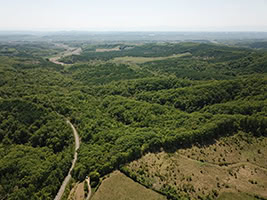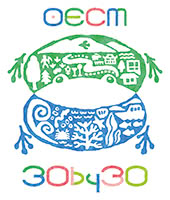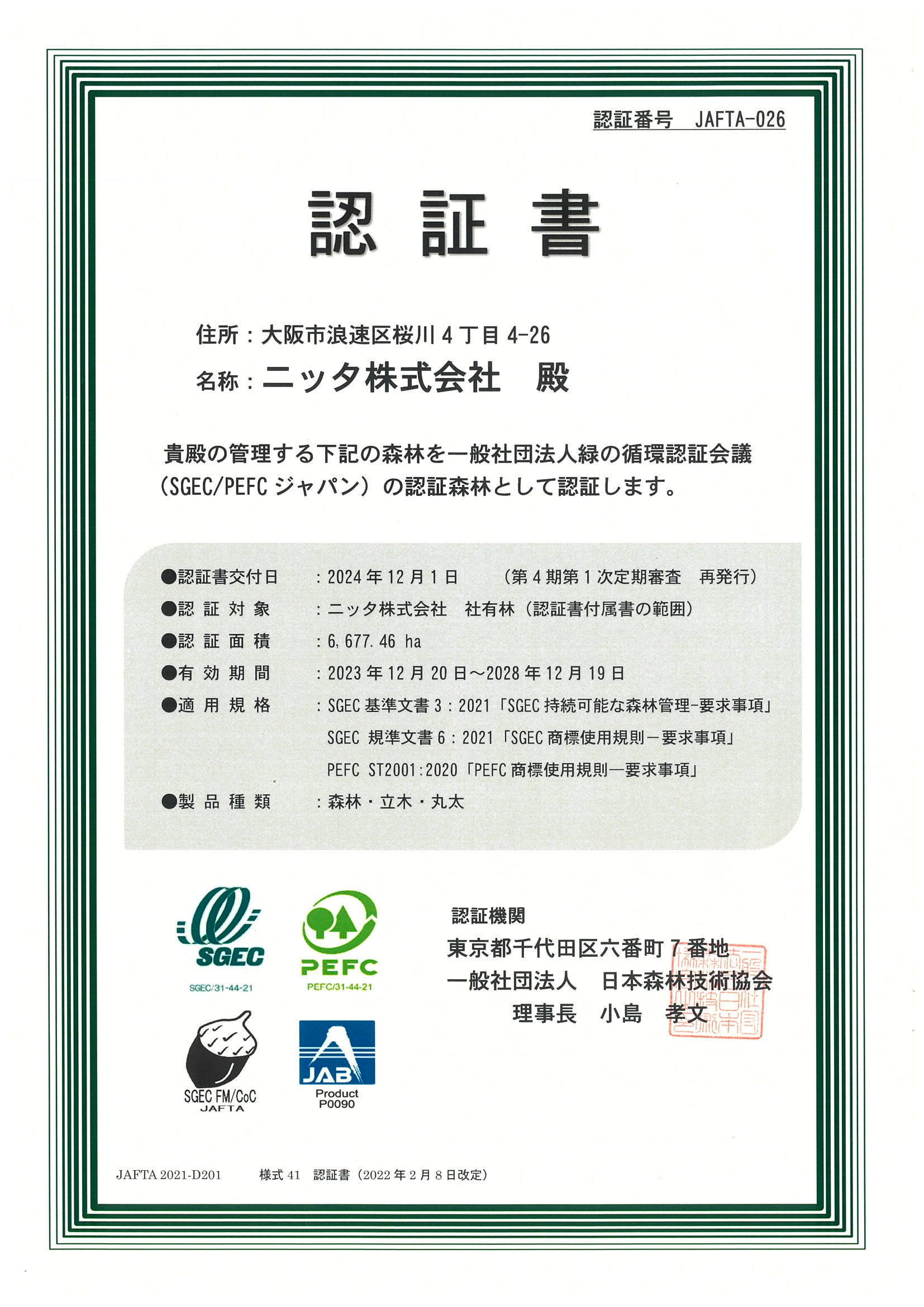Sustainability
Sustainable Forest Management
Sustainable Forest Management
Contributing to the Resolution of Global Environmental Problems through the Maintenance and Preservation of Woodland Resources
History and Purpose
In 1906, Nitta acquired a large tract of woodland in the Tokachi region of Hokkaido after searching for oak trees as a source of tannin raw material needed in the production of its products. While making effective use of those abundant resources, we’ve also worked actively to maintain and preserve woodlands since that time by, for example, planting fast-growing larch trees.
Today, we own about 6,700 hectares of forest, and we’re actively and continuously developing forests as an important global resource, including by supplying timber, providing seedlings for planting, and planting and thinning trees.

Enacting Woodland Management Policies and Earning SGEC Certification
Beyond providing timber as a natural resource, woodlands have a variety of beneficial functions, including protecting the Earth’s environment by absorbing and storing carbon dioxide and preserving biodiversity.
Reflecting our belief that continuing to maintain and preserve our company-owned forest is an important social responsibility, we’ve established a management policy to guide that process. We continue to undertake initiatives to contribute to “Life on Land,” one of the SDGs, while managing our forest in accordance with the certification standards and guidelines of the SGEC* (Sustainable Green Ecosystem Council), which administers forest certification systems.
* The SGEC aims to improve forest management in Japan against the backdrop of a worldwide decline in the quantity and quality of forests and rising interest in green consumerism. As of June 3, 2016, SGEC certification was recognized as being equivalent to PEFC (Programme for the Endorsement of Forest Certification) international certification.
Company Forest Management Policy
The Nitta Group (“the Group”) is committed to contributing to the protection of the global environment and preserving biodiversity by maximizing the multifaceted functionality of forests through the enactment and implementation of a Woodland Management Plan based on the Hokkaido Woodland Development Ordinance and the Hokkaido Woodland Development Basic Plan. To that end, we manage our company-owned forests based on the basic approach described below.
- 1.We promote the protection and nurturing of forest resources, and do not engage in deforestation or illegal logging.
- 2.To reliably implement the Woodland Management Plan in an effort to maintain and increase our woodland resources into the future, we develop structures to facilitate sustainable company-owned forest management.
- 3.In keeping with the Hokkaido Woodland Development Basic Plan, we classify company-owned forests as watershed protection forest, mountain disaster prevention forest, living environment protection forest, and timber production forest; develop a vision for each type; and undertake development and other operations as defined below while taking into account biodiversity.
- ① Watershed protection forest
In addition to carrying out appropriate growing and thinning from the perspective of ensuring a stable supply of high-quality water, we undertake operations so as to foster the development of understory vegetation and tree roots and to reduce and disperse bare land resulting from logging. - ② Mountain disaster prevention forest
We undertake operations so as to reduce and avoid bare land on the forest floor while considering conditions such as topography and geology from the perspective of fostering the formation of a regional environment that is resilient to natural disasters. - ③ Living environment protection forest
We undertake operations founded on the development and maintenance of forests that are effective in protecting against wind, noise, and other disruptive phenomena and in purifying air from the perspective of protecting a pleasant living environment in the surrounding area. - ④ Timber production forest
We undertake appropriate afforestation, fostering of growth, thinning, and other operations in a planned and systematic manner to foster the growth of trees with a mix of species and diameters that suit market demand from the perspective of creating a consistent, stable, and efficient supply of forest products such as timber.
In implementing the plan, we pursue efficient development through mechanization and work aggressively to ensure the cyclical use of forest resources by ensuring that clear-cut areas are subsequently replanted.
- ① Watershed protection forest
- 4.To contribute to Hokkaido’s “tree education” initiative and foster stakeholders’ understanding of the Group’s woodlands business, we create places where visitors can view and encounter woodlands and timber.
- 5.In our development and other forest operations, we give sufficient consideration to the need to ensure workers’ occupational health and safety while working to harmonize our efforts with regional and governmental activities and to protect the environment.
Certified as a sustainably managed natural site by the Ministry of the Environment and registered as an OECM site
Nitta’s Tofutsu Forest in Hokkaido has been recognized as maintaining a precious woodland environment and was certified as a sustainably managed natural site by the Japanese Ministry of the Environment in March 2024. It was then registered as an OECM* site in an international database in August 2024. This means that the Tofutsu Forest’s biodiversity and Nitta’s actions to protect it have been acknowledged not only in Japan but globally as well.
We will continue our efforts in sustainable forest management and biodiversity conservation by properly maintaining and managing company-owned forests.


* OECM stands for “Other Effective area-based Conservation Measures.” An OECM site is an area that is achieving in-situ conservation of biodiversity outside of conventional protected areas, such as national parks and nature reserves. OECM sites are contributing to the achievement of the 30by30 target, a worldwide goal to designate at least 30% of land and sea areas as biodiversity-protected areas by 2030.
The website of Hokkaido Nitta Co., Ltd., introduces Nitta’s forest development efforts. Please visit to find out more.
Initiatives for the next generation

As a component of our Group’s forestry business, we grow the seedings necessary for tree planting. Amid a significant decline in the number of sapling producers, we will contribute to the local communities by stably providing saplings and engaging in efficient sapling production in Hokkaido.
We have also created a Clean Larch (Elite Tree) Seed Orchard as an initiative aimed at the next generation. These trees grow significantly faster than ordinary trees. They show promise not only for meeting building material demand but also as a future CO2 sink.
Although production of full-scale saplings will still require over a decade, we plan to continue steadily carrying out this work.
Communication with the community
Hokkaido, where our company-owned forest is located, is home to unique “tree education” activities carried out in many regions to develop human resources capable of independently considering the relationship between forests and people. We are cooperating with there tree education activities as a part of our measures to strengthen relationships with local communities, enacting our own unique measures. The following are some specific activities we have carried out in the past few years.
In addition to the following activities, we are carrying out a number of activities in cooperation with relevant regions to build interest in forests among local communities. We will continue to actively roll out such activities in our efforts to raise interest in forests as a main feature of the natural environment in as many people as possible.
-

- Cooperation with training grounds for tree planting and pruning
- Provision of grounds for tree planting and pruning training by volunteers involved in lumbering, construction, etc.
-

- Provision of tree bark to Ainu people
- Provision of tree bark for use as a material in costumes worn by indigenous Ainu people in rituals
-

- Provision of a location for study by young forestry workers
- Provision of company-owned forest for on-site training hosted by Hokkaido
-

- Cooperation in Hokkaido research
- Provision of company-owned forest as a testing and research ground for new technologies researched by Hokkaido
-

- Cooperation with labor-sabing technology testing
- Provision of company-owned land for on-site testing of mechanization, undertaken by various company groups, and other organizations as a measure for labor-saving technology
-

- Social studies class at a local elementary school
- Implementing forest management education as part of social studies classes
Creating Environments That Consider Biodiversity
Conducting Biodiversity Surveys in Company-owned Forests
-
In fiscal 2021, we began conducting biodiversity surveys at two broad-leaved forest locations. The Nitta Group’s forests have been confirmed to be habitats of species designated as rare or endangered by the national government and Hokkaido Prefecture. Our basic policy is to preserve nature as is and continue to confirm the existence of biodiversity, rather than preserving and protecting specific species.
Some photographs from the surveys are shown below.
Survey Methodology
-
A local consultant conducts three site surveys each year, in the spring, summer, and fall, while noting and photographing observed species. Birds are recorded using the fixed-point method, in which the consultant watches established points for a certain amount of time and notes species when they are observed visually or heard. Animal life is surveyed using a combination of the trace method and trail cameras. Results are listed by year.
Survey Timing
-
We conducted a survey of plants in fiscal 2021, mammals and birds in fiscal 2022, and insects in fiscal 2024. Going forward, we plan to conduct each type of survey in a five-year cycle.

Fiscal 2021 Plant Life Survey
-
Precious species representing 13 families and 18 species listed on the Ministry of the Environment’s Red List and the Hokkaido Red List were observed.

Fiscal 2022 Animal and Bird Life Survey
-
A survey of animal and bird life that was carried out during fiscal 2022 found animals representing two families and two species, and birds representing three families and six species. One species of bird, the black woodpecker, has been designated a nationally protected species by the Japanese government.



